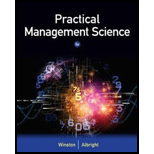
Concept explainers
a)
To determine: The way Company R can maximize the profit.
Linear programming:
It is a mathematical modeling procedure were a linear function is maximized or minimized subject to certain constraints. This method is widely useful in making a quantitative analysis which is essential for making important business decisions.
b)
To change: The model for the new constraint and identify the profit.
Linear programming:
It is a mathematical modeling procedure were a linear function is maximized or minimized subject to certain constraints. This method is widely useful in making a quantitative analysis which is essential for making important business decisions.
c)
To use: The solver table to identify the change in profit due to the change in the price of Luxury Chanelle.
Linear programming:
It is a mathematical modeling procedure were a linear function is maximized or minimized subject to certain constraints. This method is widely useful in making a quantitative analysis which is essential for making important business decisions.
d)
To use: The solver table to identify the change in profit due to the changes in lab time and the availability of the raw material.
Linear programming:
It is a mathematical modeling procedure were a linear function is maximized or minimized subject to certain constraints. This method is widely useful in making a quantitative analysis which is essential for making important business decisions.
e)
To use: The solver table to identify the change in profit due to the change in time required to process luxury brute.
Linear programming:
It is a mathematical modeling procedure were a linear function is maximized or minimized subject to certain constraints. This method is widely useful in making a quantitative analysis which is essential for making important business decisions.
Trending nowThis is a popular solution!

Chapter 4 Solutions
Practical Management Science
- The strategy of Multiple Equivalent Simultaneous Offers involves presenting several equally valuable options to the other party during negotiations. This approach benefits negotiators by creating flexibility and increasing the chances of finding a mutually agreeable solution. By offering multiple options, negotiators show that they are open to compromise, which can build trust and make the negotiation process smoother. It also helps avoid getting stuck on one issue, as the other party can choose from several alternatives that meet their needs. In my experience, using MESOs in a work negotiation helped both parties reach an agreement more quickly because each option was carefully thought out to address different needs, and this made it easier for us to settle on one that worked for both sides. This strategy can also reveal what is most important to the other party, helping negotiators understand their priorities better. agree or disagree with the postarrow_forwardExamine the conflicts between improving customer service levels and controlling costs in sales. Strategies to Balance Both customer service levels and controlling costs in sales 1.Outsourcing and workforce optimization 2. AI-driven customer supportarrow_forwardhow can you gain trust in a negotiation setting?arrow_forward
- ✓ Custom $€ .0 .on File Home Insert Share Page Layout Formulas Data Review View Help Draw Arial 10 B B14 ✓ X✓ fx 1400 > 甘く 曲 > 冠 > Comments Editing ✓ . . . P Q R S T 3 A Production cost ($/unit) B с D E F G H J K L M N $74.00 4 Inventory holding cost ($/unit) $1.50 5 Lost sales cost ($/unit) $82.00 6 Overtime cost ($/unit) $6.80 7 Undertime cost ($/unit) $3.20 8 Rate change cost ($/unit) $5.00 9 Normal production rate (units) 2,000 10 Ending inventory (previous Dec.) 800 11 Cumulative 12 13 Month Demand Cumulative Demand Product Production Availability Ending Inventory Lost Cumulative Cumulative Product Sales 14 January 1,400 1,475 15 FUERANZ222222223323333BRUINE 14 February 1,000 2,275 Month January February Demand Demand Production Availability Ending Inventory Lost Sales 1,400 #N/A 1,475 #N/A #N/A #N/A 1,000 #N/A 2,275 #N/A #N/A #N/A 16 March 1,800 2,275 March 1,800 #N/A 2,275 #N/A #N/A #N/A 17 April 2,700 2,275 April 2,700 #N/A 2,275 #N/A #N/A #N/A 18 May 3,000 2,275 May 3,000 #N/A…arrow_forwardFollow guidelines and summarize in a paragrapharrow_forwardFollow guidelines and summarize in a paragrapharrow_forward
 Practical Management ScienceOperations ManagementISBN:9781337406659Author:WINSTON, Wayne L.Publisher:Cengage,
Practical Management ScienceOperations ManagementISBN:9781337406659Author:WINSTON, Wayne L.Publisher:Cengage,
